 W
WAn altar is a structure with an upper surface for the presentation of religious offerings, for sacrifices, or for other ritualistic purposes. Altars are found at shrines, temples, churches, and other places of worship. They are used particularly in Paganism, Christianity, Buddhism, Hinduism, Judaism, and Modern Paganism. Many historical faiths also made use of them, including the Roman, Greek, and Norse religions.
 W
WBanalinga, a stone found in nature, in the bed of the Narmada river in Madhya Pradesh state, India, is an iconic symbol of worship, based on either the scriptures or cultural traditions among the Hindus, particularly of the Shaivaites and Smartha Brahmins. Stones are ancient and connote divinity. It is a smooth ellipsoid stone.
 W
WThe banana leaf is the leaf of the banana plant, which may produce up to 40 leaves in a growing cycle. The leaves have a wide range of applications because they are large, flexible, waterproof and decorative. They are used for cooking, wrapping, and food-serving in a wide range of cuisines in tropical and subtropical areas. They are used for decorative and symbolic purposes in numerous Hindu and Buddhist ceremonies. In traditional homebuilding in tropical areas, roofs and fences are made with dry banana-leaf thatch. Banana and palm leaves were historically the primary writing surfaces in many nations of South and Southeast Asia.
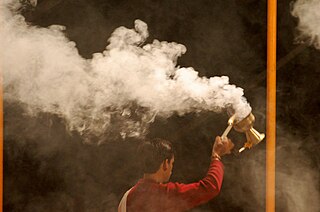 W
WDhunachi (धुनाची,धुनुची)(ধুনুচি) is a Bengali incense burner used for one of the stages during aarti, or ritualized dance worship. It is often used following the arati with the pradip.
 W
WA dhuni is a sacred site represented as a cleft in the ground. This cleft is emblematic of the yoni or female vulva and generative organ. A dhuni therefore represents a site of worship dedicated to Shakti.
 W
WDhupa (धुप) is, in Indian religions, the ritual offering of incense during puja to an image of a deity, or other object of veneration. It is also the Sanskrit word for incense or perfume itself.
 W
WA diya, diyo, deya, divaa, deepa, deepam, or deep is an oil lamp usually made from clay, with a cotton wick dipped in ghee or vegetable oils. Diyas are native to the Indian subcontinent often used in Hindu, Sikh, Buddhist, Jain and Zoroastrian religious festivals such as Diwali or the Kushti ceremony.
 W
WA fly-whisk is a tool that is used to swat flies. A similar gadget is used as a hand fan in hot tropical climates, sometimes as part of regalia, and is called a chowrie, chāmara, or prakirnaka in South Asia and Tibet.
 W
WA garland is a decorative braid, knot or wreath of flowers, leaves, or other material. Garlands can be worn on the head or around the neck, hung on an inanimate object, or laid in a place of cultural or religious importance.
 W
WGhanta is the Sanskrit term for a ritual bell used in Hinduistic religious practices. The ringing of the bell produces what is regarded as an auspicious sound. Hindu temples generally have one metal bell hanging at the entrance and devotees ring the bell while entering the temple which is an essential part in preparation of having a darshan. A bell is also rung by priests during Pūjā or Yajna – during the waving of light, burning of incense in front of the deity, while bathing the deity and while offering food or flowers. There are bells specially made to produce the long strains of the sound Aum.
 W
WIncense is aromatic biotic material that releases fragrant smoke when burnt. The term is used for either the material or the aroma. Incense is used for aesthetic reasons, religious worship, aromatherapy, meditation, and ceremony. It may also be used as a simple deodorant or insect repellent.
 W
WJyoti Kalash is a symbolic representation of Hindu goddess Durga. During Navaratri festival devotees light Jyoti Kalash, in temples of Devi, to appease her. The word Jyoti Kalash comes from combination of two Sanskrit words - Jyoti and Kalasha.
 W
WA kalasha, also spelled kalash or kalasa, also called ghat or ghot, is a metal pot with a large base and small mouth, large enough to hold a coconut.
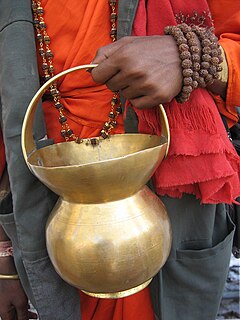 W
WKamandalu or kamandal or kamandalam is an oblong water pot, originating from the Indian subcontinent, made of a dry gourd (pumpkin) or coconut shell, metal, wood of the Kamandalataru tree, or from clay, usually with a handle and sometimes with a spout. Hindu ascetics or yogis often use it for storing drinking water. The water-filled kamandalu, which is invariably carried by ascetics, is stated to represent a simple and self-contained life.
 W
WKavadi Aattam is a ceremonial sacrifice and offering practiced by devotees during the worship of Lord Murugan, the Hindu God of War. It is a central part of the festival of Thaipusam and emphasizes debt bondage. The kavadi ("burden") itself is a physical burden, the bearing of which is used by the devotee to implore Murugan for assistance, usually on behalf of a loved one who is in need of healing, or as a means of balancing a spiritual debt. Devotees process and dance along a pilgrimage route while bearing these burdens.
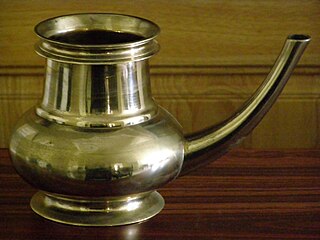 W
WKindi is a type of a pitcher usually found in old houses in Kerala and other parts of India.
 W
WA lingam, sometimes referred to as linga or Shiva linga, is an abstract or aniconic representation of the Hindu god Shiva in Shaivism. The original meaning of lingam as "sign" is used in Shvetashvatara Upanishad, which says "Shiva, the Supreme Lord, has no liūga", liuga meaning he is transcendent, beyond any characteristic and, specifically the sign of gender. Lingam is an “outward symbol” of the “formless Reality”, the symbolization of merging of the form (Prakṛti) with the formless Reality (Purusha) in transcendental context. It is typically the primary murti or devotional image in Hindu temples dedicated to Shiva, also found in smaller shrines, or as self-manifested natural objects. It is often represented within a disc-shaped platform. It is usually shown with yoni – its feminine counterpart. Together, they symbolize the merging of microcosmos and macrocosmos, the divine eternal process of creation and regeneration, and the union of the feminine and the masculine that recreates all of existence. The lingam is conceptualized both as an emblem of generative and destructive power, particularly in the esoteric Kaula and Tantra practices, as well as the Shaivism and Shaktism traditions of Hinduism.
 W
WThe litter is a class of wheelless vehicles, a type of human-powered transport, for the transport of persons. Smaller litters may take the form of open chairs or beds carried by two or more carriers, some being enclosed for protection from the elements. Larger litters, for example those of the Chinese emperors, may resemble small rooms upon a platform borne upon the shoulders of a dozen or more people. To most efficiently carry a litter, porters either place the carrying poles directly upon their shoulders or use a yoke to transfer the load from the carrying poles to the shoulders.
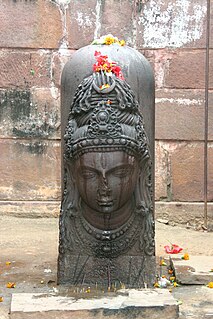 W
WIn Hindu iconography, Mukhalinga or Mukhalingam is a linga with one or more human faces. The linga is an aniconic representation of the Hindu god Shiva. Mukhalingas may be of stone or can be made of a metal sheath, which covers the normal linga.
 W
WMurti is a general term for an image, statue or idol of a deity or mortal in Hindu culture. In Hindu temples, it is a symbolic icon. A murti is itself not a god in Hinduism, but it is a shape, embodiment or manifestation of a deity. Murti are also found in some nontheistic Jainism traditions, where they serve as symbols of revered mortals inside Jain temples, and are worshiped in murtipujaka rituals.
 W
WNaivedya is a Sanskrit word meaning 'offering to God' in the stricter sense of the words. It could be any offering, tangible or intangible. A resolution, a promise or even a willingness to do, perform or restrict certain things can also connote an offering to God.
 W
WNavratra Akhand Jyoti नवरात्रों (में) अखंड ज्योति is an oil lamp that burns continuously for 9-10 days on the festival of Navaratri in the honor of the divine Devi (Durga). A Jyoti is an essential part of puja, especially at arti (Hinduism).
 W
WPanchamrita is a mixture of five foods used in Hindu as well as Jain worship and puja and Abhiṣeka which are usually honey, Jaggery, cow milk, curd and ghee. After panchamrita is used in puja and abhisheka, it is distributed as prasad.
 W
WA pandal in India and neighbouring countries, is a fabricated structure, either temporary or permanent, that is used at many places such as either outside a building or in an open area such as along a public road or in front of a house. This canopy or big tent is often used in a religious or other events that gathers people together, such as a wedding, fair, exhibition or festival.
 W
WPatravali or Pattal or Vistaraku or Vistar or Khali is an Indian eating plate or trencher made with broad dried leaves. It is mainly made from Sal leaves. It is also made from Banyan tree leaves. It is made in circular shape, by stitching 6 to 8 sal leaves with tiny wooden sticks. It is popular during traditional meals, festivals and in temples. It is a cottage industry in India where women work on weaving them at home in spare time.
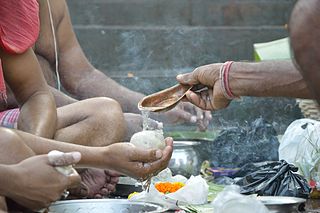 W
WPiṇḍas are balls of cooked rice mixed with ghee and black sesame seeds offered to ancestors during Hindu funeral rites (Antyesti) and ancestor worship (Śrāddha). According to traditions in the Garuda Puran, offering a pinda to a recently departed soul helps to unite the soul with its ancestors. Pindas can be placed on a recently deceased person's hands and feet on their way to a funeral pyre. Pindas are offered to both maternal and paternal lineages. When making an offering of pindas the first can be offered to the father, the 2nd their father's father, the third their father's father's father, the 4th their mother, the 5th their father's mother, the 6th their father's mother's mother, and so on to cover ancestors from all sides of the family.
 W
WPrasāda, variantly spelled as Prasādam, Prasād and Prasāda, is a material substance that is a religious offering in both Hinduism and Sikhism. Most often prasada is vegetarian food consumed by worshippers after worship. Mahaprasāda in Hinduism, similar to the langar in Sikhism, is the consecrated food offered to the deity in a Hindu temple which is then shared and eaten by the masses without discrimination. Sometimes this vegetarian offering will exclude the prohibited items such as garlic, onion, etc.
 W
WA japamala, jaap maala, or simply mala is a string of prayer beads commonly used in Indian religions such as Hinduism, Jainism, Sikhism, and Buddhism for the spiritual practice (sadhana) known in Sanskrit as japa. They are similar to other forms of prayer beads used in various world religions and sometimes referred to in English as a "rosary", reflecting similarities to Christian practices.
 W
WRangoli is an art form originating in the Indian subcontinent, in which patterns are created on the floor or a tabletop using materials such as powdered lime stone, red ochre, dry rice flour, coloured sand, quartz powder, flower petals, and coloured rocks. It is an everyday practice in Hindu households, however the colours are preferred during festivals and other important celebrations as it is time consuming. Rangoli are usually made during Diwali or Tihar, Onam, Pongal, Sankranthi and other Hindu festivals in the Indian subcontinent, and are most often made during Diwali. Designs are passed from one generation to the next, keeping both the art form and the tradition alive.
 W
WSarpa Kavu or Naga Banna is a traditional natural sacred space seen near traditional homes in Kerala state of South India and in the region of Tulunad. The site is believed to be inhabited by snakes, and the area usually contains a representation of Naga Raja and other Naga Devatas, where offerings and rites are performed during special ceremonies. This is a Hindu ritual performed by the sects like the Bunts and Nairs, and all castes hold the Sarpa Kavu in reverence, with access forbidden to the area unless for due ceremonies.
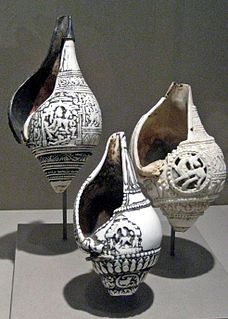 W
WA Shankha has religious ritual importance in Hinduism. It is the shell of any suitable sea snail which had a hole made for the performer's embouchure.
 W
WA shaligram, also called a shalagram shila, is a particular variety of black fossil stone collected from riverbed or banks of the Kali Gandaki, a tributary of the Gandaki River in Nepal, used as a non-anthropomorphic representation of Vishnu by some Hindus. They are typically fossils of ammonite shells from the Devonian-Cretaceous period of 400 to 66 million years ago. The black stones are considered holy because they bear symbols associated with Vishnu naturally, without any human intervention.
 W
WIn Dharmic culture, the tilaka is a mark worn usually on the forehead at the most important chakra on the body called Ajna chakra, sometimes other parts of the body such as neck, hand, chest and arms. Tilaka may be worn daily or for rites of passage or special spiritual and religious occasions only, depending on regional customs.
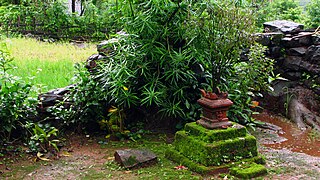 W
WTulasi Chaura, Tulasi Vrindavan, or Tulasi Thara is a small podium-like stone or cement construction in front of traditional Hindu houses, housing the sacred Tulasi plant.
 W
WUpanayana, also known as janai or janea, poita, Yagnopavita, or Bratabandha, is one of the traditional saṃskāras that marked the acceptance of a student by a guru and an individual's entrance to a school in Hinduism. The tradition is widely discussed in ancient Sanskrit texts of Hinduism and varies regionally. The sacred thread is received by the boy during this ceremony, that he continues wearing from left shoulder to the right crossing the chest thereafter. Generally this ceremony should be done before the age of 16.
 W
WIn Hinduism, vibhuti, or bhasma or thiruneeru, is sacred ash made of burnt dried wood used in Agamic rituals, burnt cow dung, or cremated bodies. Hindu devotees apply vibhuti traditionally as three horizontal lines across the forehead and other parts of the body to honor Shiva. Vibhuti smeared across the forehead to the end of both eyebrows is called tripundra. According to the Shiva Purana, the particles of ash which cling to the skin when tripundra is applied are to be considered to be individual lingams. The scriptures further state that bhasma purifies the soul, elevates the devotee of Shiva and works done without wearing bhasma are infructuous. There are various methods for the application of the ashes according to the purana and various mantras to be recited during application.
 W
WThe Xorai, a manufactured bell metal product is one of the traditional symbols of Assam, which is considered as an article of great respect by the people of Assam. In simplistic terms it is an offering tray with a stand at the bottom which is used in felicitations also. There are Xorais with or without a cover on the top. Hajo and Sarthebari are the most important centers of traditional bell-metal and brass crafts in Assam.